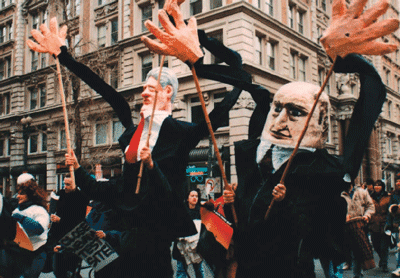Nadine Bloch '83 melds art and activism
Nadine Bloch '83 melds art and activism
Amidst a collection of hula hoops, a headless mannequin, and other discarded treasures, former President Bill Clinton sits in front of a chocolate-brown house with teal trim outside Washington, D.C. But this particular Clinton is a giant papier mâché puppet of comic proportions—and the house he safeguards is that of his creator, Nadine Bloch '83.
Inside, Bloch sits beneath the oversized head of a moon-faced female puppet, which has been separated from its one-breasted, mastectomy-scarred body. Petite and compact, with a shock of auburn curls and a sharp nose, Bloch seems dwarfed by this huge, disembodied creature, which she used in a protest calling on Congress to remove pesticides from our food supply. "It's in your face," the veteran activist says of using puppets to agitate for the environment and social justice. "It's entertaining, empowering, emotive, educational, and accessible—and it actually makes a difference. People feel like they can participate."
Not all of Bloch's artwork takes the shape of puppets or even people. This summer, she created several pieces that look like blocks of ice with various natural objects inside them for an installation on climate change—part of her ongoing commitment to promote a "greener and more peaceful future." Those efforts currently comprise a broad range of activities. She works with her fourth-grade daughter's Young Activist Club to ban disposable lunch trays from schools, teaches seminars on using art in protests and organizing non-violent campaigns, started a group to help Washington become a sustainable city, and is continuing her long association with Greenpeace. An interest in art, a background in environmental science, and an activist nature are all threads Bloch has woven to create a career that has included sailing with musician Pete Seeger to clean up the Hudson River, hanging a banner from the Sears Tower in Chicago to protest nuclear weapons—even getting arrested with actor Martin Sheen several times, including once at a Nevada nuclear testing site.

Bloch's activist career traces its roots to Cornell, where she enrolled with the intention of becoming an art therapist, but found herself drawn to science classes and research into the effects of nuclear war on aquatic ecology. That, along with the era's debate about reinstating the draft, ignited an activist spark that had been nurtured by her mother, whom she describes as the quintessential community volunteer. "It all just seemed like an incredible waste of resources," says Bloch of the nuclear threat and the draft. "I couldn't help but think, Why are we paying for our own death? Why are we not investing in improving our future instead of destroying it?"
On the Hill, Bloch worked on campaigns to get students to pledge not to work for companies in the nuclear industry or defense contracting. Even then, she blended theater with protest. "Big corporate warmongers like Lockheed and Haliburton would come to recruit on campus, and we'd dress up as three-headed monsters and go into their fancy receptions and snort and spit and eat the hors d'oeuvres and disrupt things," says Bloch. "We'd get kicked out and picket outside." After graduation, Bloch signed on to the Clearwater, Seeger's 106-foot sloop, whose crew sailed up and down the Hudson doing environmental education and advocacy. Bloch worked there off and on throughout the Eighties. "I learned a lot of what I know about organizing, community outreach, and hands-on experiential education there," she says. "Learning the ropes as you use them was instrumental for me."
Bloch moved from the Clearwater to one of Greenpeace's boats, working to stop the military from doing nuclear weapons tests. (The activists' reasoning was that they could prevent testing by being on site, because the military would-n't want to hurt civilians.) Nancy Bernstein '85, who worked on the Clearwater and at Greenpeace, remembers Bloch and several others dangling on ropes 200 feet off a bridge over the Columbia River in an effort to stop a test. "A reporter asked if she was uncomfortable hanging there," Bernstein recalls. "She said, 'Well, not as uncomfortable as I am with nuclear weapons.'"
Bloch eventually became a trainer for Greenpeace and then the Ruckus Society, a group of environmental and social justice organizers she still works with today. Through it all, Bloch used art—whether making stencils for campaigns, painting banners, working with theater groups, or creating giant puppets. "We once built this thirty-foot nuclear weapon, put it on the [National] Mall, and had people smash it to smithereens," Bloch says. "It was completely cathartic. The act of creating the world you want to be part of, or destroying what you believe is wrong, is totally inspiring."
Of course, not everyone is inspired by Bloch's work. She has been investigated by the Maryland State Police and federal agencies and arrested more times than she can count. And she is regularly derided as a hippie. "People say you're vaguely reminiscent of the Sixties," says Bloch. "That's the touchstone for people who don't understand. But there are more people doing progressive, social justice work than ever before—people who are working with teen mothers or in homeless shelters, people protesting in front of bulldozers. There are millions of people taking care of the community at every level. That's the hopeful piece."
— Kelly DiNardo '98


